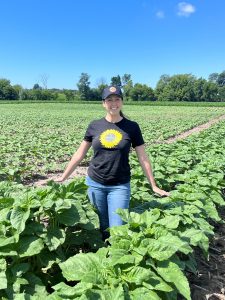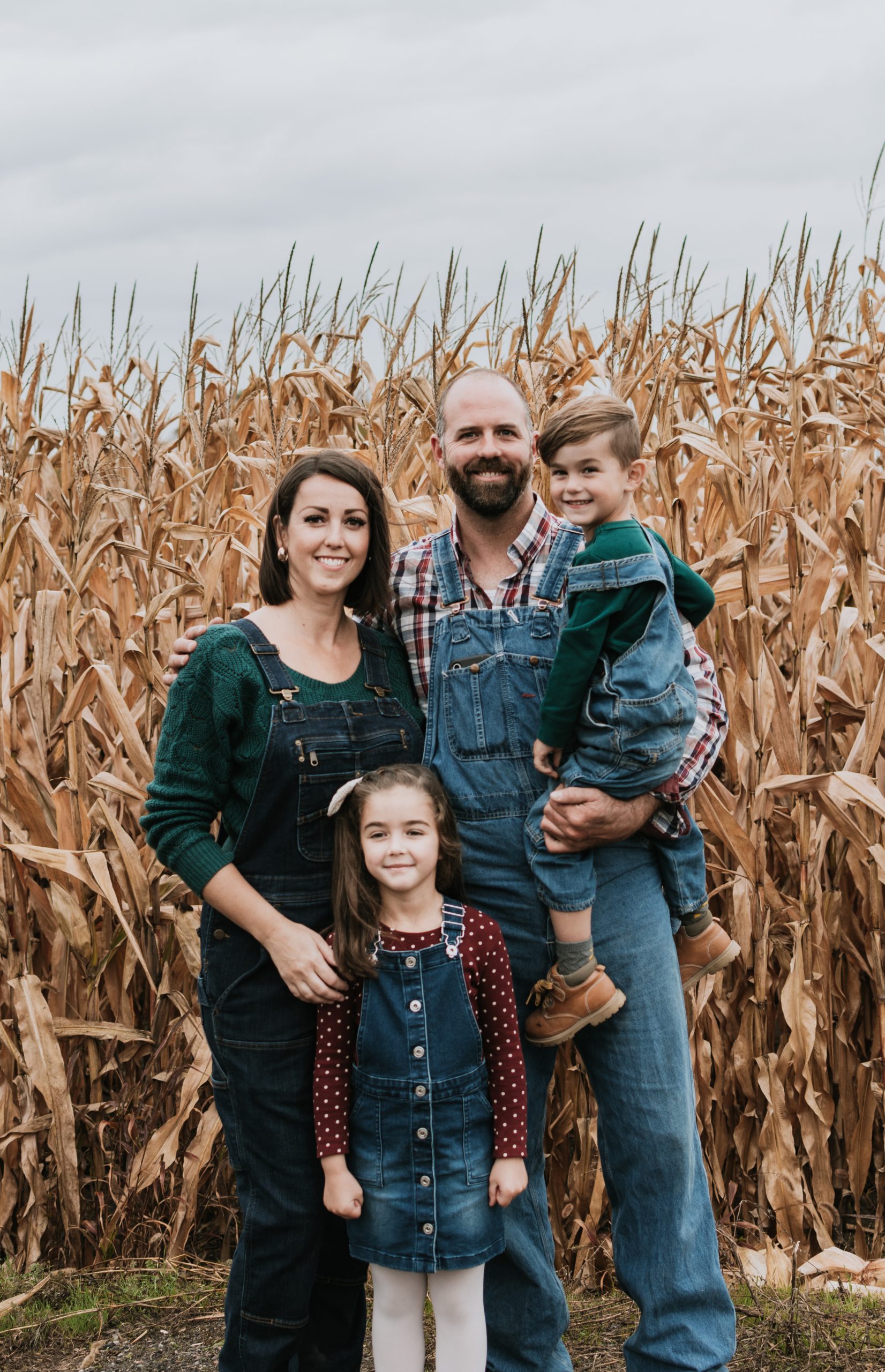The following story is from Better Farming’s November 2022 Issue.
BRAGG FARMS
Where the community can come and learn about real agriculture.
By Colleen Halpenny

Image provided by the Bragg Family
You’d never guess that Brittany Bragg wasn’t raised in the agricultural community, but as a team member of Bragg Farms in Bowmanville, Brittany has found her surprise calling.
Established in 1843, Brittany’s in-laws have called their 200 crown deeded acres home for eight generations. They began custom farming when they took over the operation, and then in 1991 launched bird seed blends. Well known in the area today for their bird seed, the Braggs offer 18 different blends all made on site.
“Prior to the pandemic, I was running a daycare out of our home, and wasn’t much involved in the day-to-day of the business. When the lockdowns really hit, what was shocking was that sales improved. With all the unknowns, we shut down the daycare and I came onboard full time with the marketing and sales end,” Brittany says.
With her sales experience, Brittany realised that seed sales were on the rise as feeding the birds was a safe activity people could do at home during the pandemic. Recognizing the potential, she knew that increasing engagement and putting the business in the spotlight of a growing community would give them additional security.
Working with a social strategy company, Brittany began to rebrand Bragg Farms.
“We revamped the logo, built an entire new website, and made it easily accessible for customers to purchase from. But this was also a big learning time for me. I had to learn a lot about the products, understand the ways in which they were grown, harvested and how we could best organize them in a way that customers could easily find what they were looking for,” she says.
With positive community response, Brittany began to explore other avenues to entice consumers, noting the extreme popularity of “sunflower fields being flocked to for pictures.
“We already grow sunflowers for the bird seed,” says Brittany. “Why not open the fields up and allow the community to experience a living viable crop that we are going to harvest? Being able to share the full crop cycle with them has been really engaging.”
Prior to the pandemic, all crops grown were harvested as a grain or seed for food or livestock. Interested in offering a fresh option to consumers, Brittany thought it would make sense to grow vegetables. Pulling on her experience with daycare children who would love to dig in the dirt, a pilot project of “pick-your-own” began.
“Ontario is heavy with pick-your-own berries and apples. We wanted to offer a different experience so instead, we offer potatoes. Our pilot year took off so well that we increased acreage the next year. Anything we venture into, we want to be courteous of the other farms in the area. A lot of land is getting sold in the area, so we want everyone to flourish in which ever way they can,” she says.
Two years into the revival, Brittany shares that it has been a whirlwind of ups and downs. Entering the tourism area coupled with general farming means there really is no time off from spring planting to harvest.
“We constantly are re-evaluating, asking if we’ve made it too hard on ourselves. But the push to tourism predominately means another revenue source for the business given that land is disappearing. If we don’t get smarter about how to use our land, there’s no guarantee that we will make enough revenue to stay around for another eight generations,” she shares.
Brittany challenged herself with the question,” What can I give my customer for free?” and recognized that earning trust and loyalty from consumers meant more than offering a quick afternoon on the farm. She started to educate herself on more than just the products they sold.
With a bachelor’s degree in education, Brittany was familiar with the need to dig for respected research. She set to work learning the science behind what birds were looking for, what birds were present in the area, what the seasonal changes in their nutritional needs were, cropping practices and anything else that a visitor may have asked.

Photo taken by Ash Adams
“It’s as simple as the difference between white and brown eggs. The general consumer doesn’t know the why behind it so I made the effort to educate myself, share the simple facts and pick my husband’s brain. Those who grow up in the industry can take for granted the knowledge they have and assume everyone would know the same.
“Visitors began to respond to our authenticity and see that we cared about their experiences and relationship with food. Educating yourself and the consumer with reliable trusted sources is how we bridge the gap between the fields and the grocery store shelves,” she says.
What are your roles on the farm?
When I first joined the farm, I led the rebranding project. We had previously been known in the local community as Bragg’s Wild Bird Seed and that name was limiting us from expansion or growth. Through a massive website update and overhaul of social platforms, promotion of the company is my main job title. I also plan and lead the tourist events, build relationships with other local businesses for collaboration and sell and deliver our potatoes wholesale to a number of restaurants and bakeries. I also work in the retail store helping to educate our customers on the science of bird feeding and bagging birdseed mixes when needed.
How many non-family members does your farm employ?
This changes throughout the year as our seasons change. During tourism we have at least three to four on-call, part-time employees. Our retail store where birdseed is sold also requires three to four part-time employees. We have at least two to three staff that stay on year-round. During harvest, we will hire temporary employees to help harvest and transport the crop back to the farm.
Hours you work per week?
Being an entrepreneur, my brain is never not thinking about the farm, about where I want to take the business, and I’m constantly being inspired even when I’m not looking for it. Ideas come to my mind in the middle of the night.
Hours you work in the office?
Depends on the time of year. Due to developments in technology even when I need to deal with invoicing, emails, payment transfers, etc. and I’m out in a field for tourism, I can send and receive through my laptop or cell phone permitting I can get a Wi-Fi signal or work from my data plan. So I’m doing office work out in the field, while my kids are at recreational activities and while I’m on the road.
Three items you’re never without?
iPhone, Carhartt overalls, sun protection.
How has social media impacted your view of agriculture?
Social media has been an absolute blessing for us. It allows a population of people to see what’s involved and happening on our farm, how seasonal changes impact the farm and what’s challenging us or happening for us year-round. Our following has grown from only 100 people when I took it over two years ago to over 5,000 authentic followers who support our business.
Most valuable lesson you’ve learned?
When people start to copy you, it’s a compliment and it means you’re doing the right thing. I pride myself on being innovative and bringing new experiences to our region.
What’s the best time of the day?
For being productive, first thing in the morning after my kids have gone to school and I can tackle work without interruption. But my favorite part of the day is briefly leaving the farm to go pick them up after school. Regardless of all my titles, motherhood is incredibly important to me and I love being a mom.
Best farm machinery purchase? Or top purchase goal?
For me, because I’m developing edible products, it’s usually something food-based. For my husband, it will always be machinery on the farm. Any tool that makes us more efficient is a goal.
How has working alongside your family or partner or raising a family on a farm impacted your dynamic?
Working alongside my partner has made us strong. We’ve always been supportive of each other’s aspirations but since I came on board with the business, our goals for the farm are aligned. We have a great appreciation for each other’s contributions.
Biggest challenge for you?
Biggest challenge for me is the home-to-work life balance. I struggle with mom guilt a lot as we work so much. I must consciously make sure that I make time for my kids. Some seasons are harder than others.
How do you measure or celebrate success?
Usually it’s not celebrated. We always compete with ourselves. So we have tiny victories and we are happy about them but then that just sets a new goal to top.
Best mental health strategy?
Pray. I pray a lot. I must believe that nothing that is meant for me will pass me by. And when I’m fragile or exhausted or burnt out, an evening with friends is usually all it takes for a good pep talk.
What do you love to do on your time off?
I’ve always had a soft spot for interior decor and love home renovation projects. I also love to attend my kids’ recreational activities.
If you weren’t a farmer, what would you do?
My first career choice was to be an elementary school teacher and I’m qualified to teach junior kindergarten through grade six. I still feel like I get to educate the community every day with my role on the farm.
———————————————-
Thank you to Better Farming for allowing us to re-print this great story.
